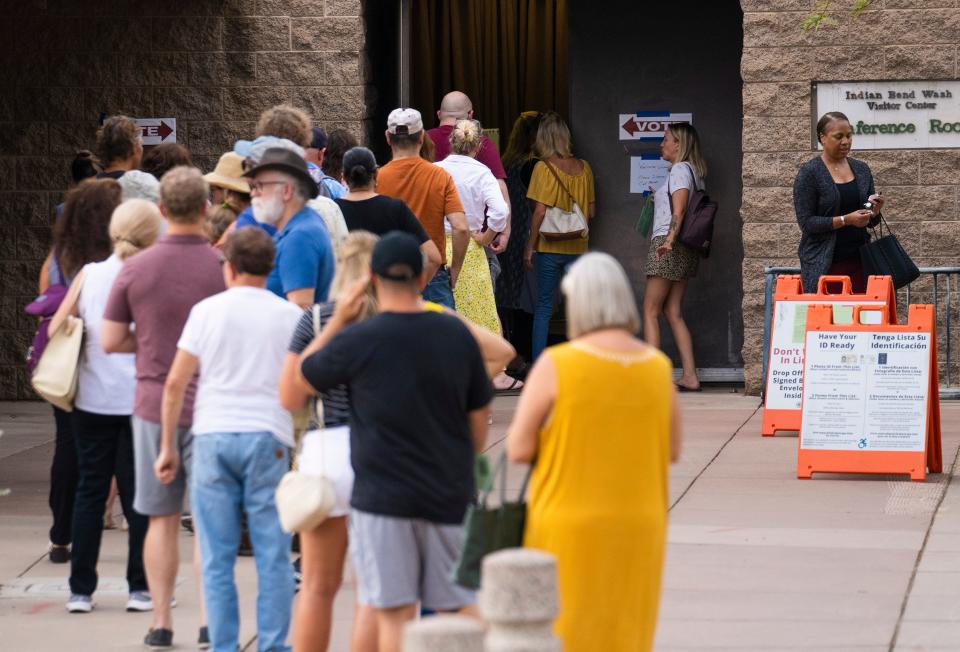Arizona has a history of its voting laws coming under federal scrutiny. That continues today
EDITOR'S NOTE: This page is part of a comprehensive guide to voting rights across the U.S. and in Puerto Rico.
Democracy is a relatively new concept in the last of the 48 continental states, blazing ahead at times like an express stagecoach even as it left some people behind.
American voting rights in Arizona began in 1865, two years after Congress granted territorial status. The 1st Arizona Legislature announced that regular elections for legislative representatives and territorial delegates to Congress would begin that year.
The Legislature bestowed voting rights on "every white male citizen of the United States and every white male citizen of Mexico" now within the territory's boundaries. Citizens could vote in several elections, but not for president or the governor, who was chosen federally.
Many Mexicans who chose to stay north of the new border faced discrimination and exclusion from most public offices. But men occasionally broke barriers, like Nabor Pacheco, a Mexican American elected as the first Latino sheriff of Pima County in 1904.
Black people were legally allowed to vote after the passage of the 15th Amendment, but not Native Americans or people of Asian descent. Nor could women of any race vote in Arizona.
Literacy tests targeted people of color
Democrats introduced a literacy test in the early 20th century to blunt the vote of Spanish-speaking Mexican Americans who tended to vote Republican. Congress deleted the literacy law in Arizona when it granted statehood in 1912, but lawmakers swiftly reinstated it.
At the same time, Arizona’s founding fathers created a powerful tool of democracy, the right of citizens to create law through ballot initiatives. Male voters passed women’s suffrage as the first initiative.
Arizona's literacy law, which required voters to read a section of the U.S. Constitution, disproportionately affected Arizonans of color for decades. Federal intervention gave Indigenous people the right to vote in Arizona in 1948, and Asian Americans followed in 1952. But the literacy test meant that in practice, as many as 90% of Native Americans in Arizona were unable to vote until it was revoked permanently.
Arizonans of color generally voted for Democrats after World War II and viewed literacy challenges now led by Republicans as voter intimidation. Former Chief Justice of the U.S. Supreme Court William Rehnquist was accused of harassing Black voters in Phoenix on Election Day in 1962 while he was an election challenger for the Republican Party.
The Voting Rights Act of 1965 banned poll taxes and literacy tests in all states. But Republicans in the Arizona Legislature passed a “voting reform” law in 1970 that included a literacy requirement. The U.S. Supreme Court struck that provision down.

Federal oversight of Arizona's voting laws instated
Those years of discrimination resulted in extra scrutiny by the federal government under the Voting Rights Act. Election law changes needed "preclearance" from the Justice Department, which blocked 17 attempts by the Legislature to change voting procedures in the 1980s and 1990s.
An ahead-of-its-time change in 1991, however, let Arizonans vote by mail. It was a popular and virtually uncontroversial feature of elections — until then-President Donald Trump’s defeat in 2020.
Apart from mail voting, the state made changes that restricted some voters. Concern over illegal immigration drove Arizona voters to pass an initiative in 2004 that dictated new proof-of-citizenship requirements for registering to vote. Hundreds of Navajo voters were turned away at the polls. The U.S. Supreme Court shot down the law in 2013, leading to a dual ballot system that allows people to vote without such proof in federal-only elections.
That same year, the court eliminated preclearance. Changes followed, including a law making the collection of ballots from non-family members a felony, which the Supreme Court upheld last year. Justice Elena Kagan, in her dissent of the 2021 opinion, criticized it as a "tragic" weakening of the Voting Rights Act.
This year, Gov. Doug Ducey signed a law to require proof of citizenship to vote by mail or in presidential elections, the subject of the 2013 Supreme Court ruling. Groups that advocate ease of voting and immigrant voting rights promptly sued, as did the Justice Department.
The law was apparently inspired by baseless claims made by Trump and his most avid supporters about a large number of noncitizen voters. Trump’s loss in Arizona also led to a partisan ballot review in Maricopa County.
Other election conspiracies sparked more than 100 bills by GOP lawmakers this year. Nearly all of them failed due to a small group of Republicans.
This article originally appeared on Arizona Republic: Arizona has a history of its voting laws coming under federal scrutiny

